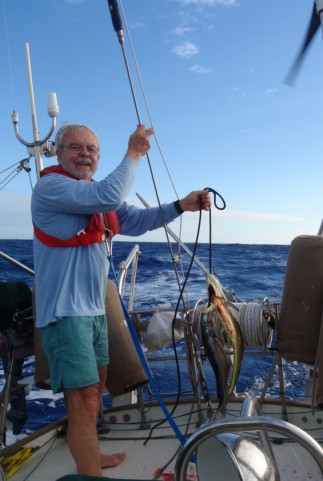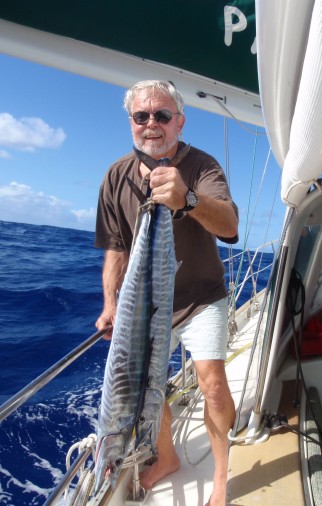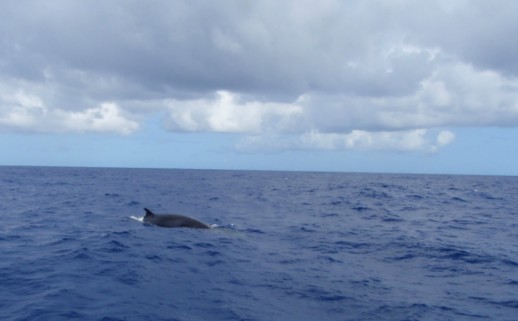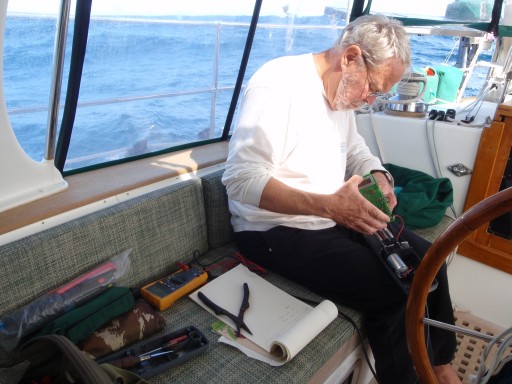CROSSING THE ATLANTIC
Weather forecasts looked as through January 16 would be a good day to leave the Canaries and head across the Atlantic for the Lesser Antilles – probably Antigua. However, it was a bit windy in the morning, and we were concerned about moving around in the marina including a stop at the fuel dock. Our friends on Tandem, also heading for Antigua, were bolder than us, and they left around 10:30 AM. We saw them off and went for coffee and to revise our plan. About an hour later, there was a lull in the wind, so we quickly left our slip and moved to the fuel dock from where we could easily leave in almost any wind. One more hour to fuel and pay our final bill, and we were out of the marina at 12:35.
We would not make landfall again for three weeks, and that landing was changed to St. Lucia rather than Antigua as originally planned. A lot happened during those three weeks, and we will condense it here in to four topics:
In a word: miserable. We had big winds (over 40 knots at times) and big rolly seas (15 feet at times) almost the entire trip.
Much to our surprise, when we left Lanzarote, we actually had light winds for a few hours, and we poled out our genoa so that we could sail dead downwind. We did not know that our pole would remain up almost constantly for the next three weeks.
We had light winds and sloppy seas for a few days, then the winds increased on our fourth day out. The wind would occasionally drop to the teens, but then it would increase back to the high 20s and low 30s. By our eighth day, the winds were varying from the mid 20s to 40, and this persisted for three days. The winds improved slightly by day 12, but the roll was intolerable. We tried changing course to improve the roll, but we had seas coming from three directions, and we could not escape them. We also had frequent squalls – some quite lively.

Miserable seas
Although we had initially planned to head to Antigua, the weather forced us south, and we sailed mostly dead downwind using varying small scraps of sail. Heading dead down exacerbated the roll problem. A few times we could not tolerate the roll, and we would go on a broad reach to the north just to relieve the roll. But then we would have to head back down again.
As we approached St. Lucia, we wanted to slow down so that we could make landfall in daylight. However, the winds and seas were both big, and we had to sail on in. We arrived a few hours before daylight.

A pair of mahi
We did not see as much wildlife on this passage as we expected, but we did see two things memorable. One involved dolphins and bioluminescence, the other whales.
Bioluminescence is the emission of light by a living organism. Think glowworm or firefly. It is common in the ocean – usually produced by plankton. We often see small displays; however, on the morning of our fourth day, we saw quite a show.
A few hours before dawn, we noticed streaks of bioluminescence coming toward the boat. Then we saw dolphins swimming near the cockpit, and they were glowing a purplish blue. Their movement through the water was stimulating the plankton to emit light, and it was outlining the dolphins. We could even see details on the dolphins. It was a spectacular sight!
Our other memorable wildlife encounter was with minke whales. Minkes are baleen whales. They are grey/black above and have white bellies. Their pectoral fins are also white. The two we saw were probably 20 to 25 feet long.
It was day 15, and we had had a miserable night with many squalls and 180 degree wind shifts. Both our mainsail and genoa had been damaged during the night, and we were taking down the genoa. The whales appeared very close off our port bow as soon as we turned the boat up in to the wind, and they stayed with us until we hoisted the #2 and headed off back downwind. This is the first time we have seen Minke whales.
We also caught a few fish, but it was too rough to fish most of the time. On day 14 we caught a small mahi, and then we caught a second one before we got the second lure out of the water. Three days later we caught two wahoo – again, a second one hit before we got the second lure out of the water.
We had a few serious gear failures on this trip. The most problematic were two autopilots, our refrigerator, and two sails.
Big winds and seas are demanding on autopilots, and we had our first failure before dawn on day 5. We have a small Raymarine tillerpilot that connects to our windvane and uses very little power. However, the conditions were too much for it. When we brought it to the cockpit to look at it, it was frozen. It also had loose parts rattling around inside and it smelled burnt. Not a promising prognosis. We replaced a burned out diode with a fuse, and it worked for another hour, then it died – not to be resuscitated again.
On day 6, our primary Nexus autopilot failed. This is the autopilot that was supposedly rebuilt in La Linea, Spain, but we learned it was not. On close inspection, we could see that it had never been opened. And when we got it apart, we could see that the brushes had not been replaced as we were told they had. Fortunately we had parts on board, and we replaced one of the two brushes underway, and it resumed working – for a while.
On day 7 our refrigerator quit working. We had freon on board, and we hoped that recharging the system would solve the problem, but getting access to the unit was challenging on this very rolly night. We emptied the locker containing all our cookware and removed slats and boards containing the frig. As Bud tried to work on it, he would slide across the cabin sole banging his head on the stove as he slid to port. We finally put a piece of non-skid under his hip and stuffed pillows above his head and below his feet to keep him from sliding. Meanwhile the freezer had defrosted, and the bottom of the frig was awash in nasty stinky water. But we got it working again – for a while.

They seem to come in pairs out here
On day 15, before dawn, we sustained damage to our mainsail and genoa during a very squally night. The clew tore out of the mainsail, but we were able to work around that. We just kept a reef in it. And the foot of the genoa tore. That required that we took the sail down and replaced it with our #2.
On day 18, our frig and freezer were full of fish, and the temperature started rising again. We again recharged the system with freon, but it stopped working. And it would not work again until we had it repaired in St. Lucia. So we lost lots of food, and we had another stinky mess to clean up.

One of the minke whales that visited us.
And later that same day, the autopilot started acting up again. We could keep it working marginally with frequent power resets, but it worsened over the remaining days.
After arriving in St. Lucia, we also discovered other problems. Our wind generator was not working. Our staysail furler was broken. And our steaming light was damaged.
Obviously the big winds and seas were hard on our gear, and they were hard on us. But nothing was as challenging to us as the creak.
Passage is getting old, and she has developed a few creaks. She has had a small creak at the nav station for a few years when on a starboard tack. However, on this trip, the small creak became an ear-splitting ripping sound that destroyed our sleep and nearly drove us mad.
It was incessant. We would maybe get a break for ten seconds every hour. Otherwise, it was constant. And it was loud. It was a series of ripping sounds. It sounded like the boat was ripping apart. And it was inescapable. It resonated throughout the boat, and it easily penetrated ear plugs.
Under the best of circumstances, passages with only two on board can be demanding due to the lack of sleep. Our sleep was further limited by the winds/seas and gear problems. Then the creak… We could have better tolerated all the other issues on this passage if we could have gotten a bit more sleep.
So it is probably accurate to summarize our passage as miserable, and we shared our misery with our friends on Tandem daily. Tandem had left Lanzarote two hours ahead of us, and we did not know if/when we would next see them. But we decided to make daily radio contact so long as we were within range. They too were headed to Antigua, and they too changed course to St. Lucia. And they were never more than 100 miles away from us. We could not have maintained such close contact if we had tried, but it just worked out that way. So we had daily radio contact (more than once a day on a few really lousy days), and we commiserated. They arrived in St. Lucia four hours ahead of us. Our passages were remarkably similar except they had three persons on board and no creak (read much more sleep). We really enjoyed our contact with them.

Fixing stuff
In the end, our passage took 501 hours – three hours short of three weeks. We traveled 2,948 miles. Our slowest day was 117 miles for an average of 4.8 knots, and our fastest day was 165 miles for an average of 6.8 knots. Our overall average was 5.88 knots per hour. We are both glad that this one is over!
Follow us to the Caribbean.